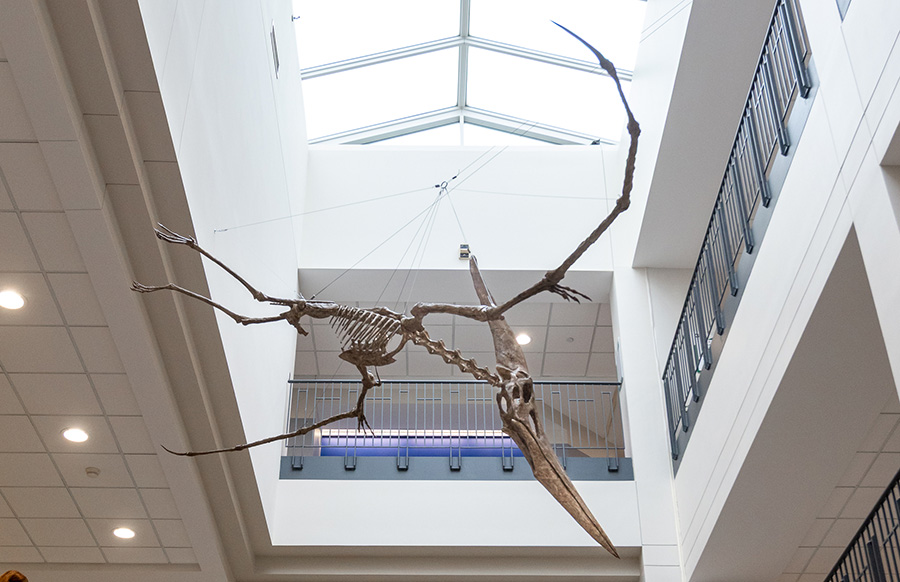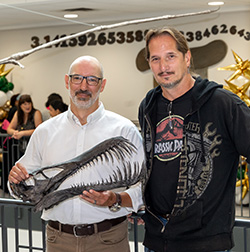
Students entering the Crane Liberal Arts & Science Building this fall will be greeted by a spectacular new resident. A life-size replica of a pteranodon with a 20-foot wingspan is now suspended mid-flight between the second and third floors of the building’s atrium.
The prehistoric reptile was officially unveiled during the college's In-Service Week, a week of professional development for faculty and staff that precedes the start of each academic semester.
The dramatic display is the culmination of a cross-departmental collaboration sparked by a simple question: How can we make building artwork at Washtenaw Community College more exciting for students?
Theresa Hunt, Manager of Instructional Operations & Support Services at WCC, had been working to update the building’s art following a recent renovation. A beloved collection of dinosaur illustrations had been pulled from storage, but its outdated framing presented a challenge.
“When reinstalling the artwork didn’t work out, I started thinking bigger,” Hunt says That’s when inspiration struck.
 Hunt recalled that Shawn Deron (right), a WCC Transportation Technologies faculty member with a fondness for 3D printing
technology, had previously 3D-printed dinosaur bones for Biology faculty member David
Wooten’s labs.
Hunt recalled that Shawn Deron (right), a WCC Transportation Technologies faculty member with a fondness for 3D printing
technology, had previously 3D-printed dinosaur bones for Biology faculty member David
Wooten’s labs.
She mocked up an image of a flying pteranodon in the atrium and shared it with Deron — who was instantly on board.
Deron said he had been eagerly awaiting the opportunity to create a large-scale piece after working with Wooten to 3D print dinosaur heads and bones — items designed to be passed around a classroom and investigated.
He first created a scale model to confirm the project’s feasibility, and then began printing, assembling and painting hundreds of parts to exact specifications.
Each bone was painstakingly glued and reinforced with copper tubing, then finished with realistic fossil textures.
Meanwhile, Wooten brought scientific authenticity.
“The pteranodon was digitally scanned from a real fossil, so even the tiny cracks in the crest were preserved,” Wooten noted. “It’s museum-quality — and students now get to walk right beneath it.”
Roughly one month after Deron first started printing parts, a team gathered to complete the final installation. It took just over four hours to hang the prehistoric predator in its new home.
“We wanted to make the building more interesting for students,” Hunt said. “We want them to be excited to take science classes — to be immersed in what they’re learning. What better way to do that than by flying a pteranodon right over their heads?”
What is a Pteranodon?
WCC Biology instructor David Wooten explains the pteranodon lived during the age of dinosaurs — about 85 million years ago — but were not dinosaurs themselves. The prehistoric reptiles went extinct around 66 million years ago, during a mass extinction caused by asteroid impact.
The pteranodon’s wings were formed from a membrane stretching from an elongated fourth finger to its hind limbs, and it likely fed on fish, diving or skimming over the ocean. Males boasted large head crests used for display, while females were more robust to support egg-laying.
Tags: 3D Printing, August 2025, Campus News, On The Record
